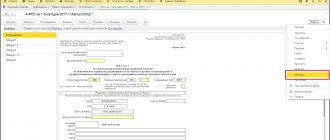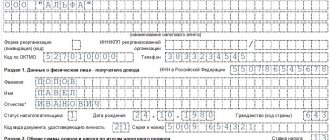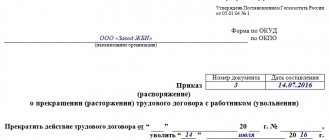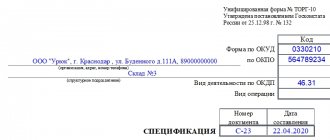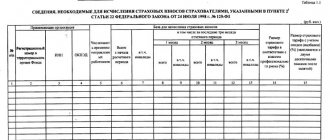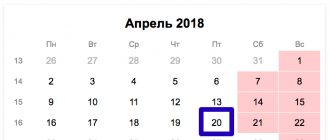What are invoices for: basic knowledge
An invoice is a documentary basis for the buyer to accept the VAT amounts presented by the seller for deduction (refund). This follows from paragraph 1 of Article 169 of the Tax Code of the Russian Federation. Tax legislation requires an invoice to be issued every time you sell goods, work, services or property rights. Invoices can be generated on paper or electronically. The paper form and the rules for filling it out are defined in Appendix No. 1 to Decree of the Government of the Russian Federation of December 26, 2011 No. 1137.
Decree of the Government of the Russian Federation dated December 26, 2011 No. 1137 approved the current forms and Rules for filling out (maintaining) the following documents used in VAT calculations:
- invoices (Appendix No. 1);
- adjustment invoice (Appendix No. 2);
- log of received and issued invoices (Appendix No. 3);
- purchase books (Appendix No. 4);
- sales books (Appendix No. 5).
If the seller wishes to send invoices to buyers electronically, the buyer is required to agree to this. At the same time, the means of receiving, exchanging and processing invoices electronically between the seller and the buyer must be compatible. They must comply with the established formats (paragraph 2, paragraph 1, article 169 of the Tax Code of the Russian Federation). Invoices are issued and received electronically in the manner approved by Order of the Ministry of Finance of Russia dated November 10, 2015 No. 174n.
General requirements
An invoice is the only document on which you can claim a VAT deduction (clause 1 of Article 172 of the Tax Code of the Russian Federation). A cash receipt with the VAT amount allocated will not work.
The Federal Tax Service launched the service “checking the correctness of filling in invoices” in test mode
An invoice can be issued even for transactions not subject to VAT (for example, under the simplified tax system). After all, the Tax Code gives the right not to draw up a tax return, but also does not prohibit it, you just need to enter “Without VAT” (letter dated November 7, 2021 No. 03-07-14/64908).
There is no need to include transportation services in the invoice for goods (Letter of the Ministry of Finance dated April 13, 2021 No. 03-07-09/21127).
If you need to cancel an invoice (for example, the document was issued prematurely), then the customer needs to write a letter stating that the invoice was issued incorrectly. To cancel an entry in an (adjustment) invoice, you must use new pages in the purchase ledger for the quarter in which you made the incorrect entry. (letter dated December 26, 2021 No. 03-07-09/77996).
Invoices must be issued within 5 business days of shipment or service. The day of shipment is also included in this period (letter of the Ministry of Finance dated October 18, 2018 No. 03-07-14/74899).
If prepayment and shipment of goods occur within 5 calendar days, i.e. occur in the same tax period, the seller may not issue an invoice for the advance payment (Ministry of Finance of Russia in letter dated November 10, 2021 No. 03-07-14/65759).
Suppliers and buyers have different approaches to calculating VAT. The supplier charges VAT on the dates when all advances are received and shipment occurs. The buyer reflects VAT on the dates specified in the invoices (you can also reflect invoices of the reporting quarter received after the end of the quarter but before filing the declaration).
Replace the primary with an error with a new one
prohibited by the accounting law. Corrections need to be made. (Letter of the Ministry of Finance dated October 23, 2021 No. 03-03-10/69280).
Another change to the invoice form
The last time the invoice form changed was relatively recently - from July 1, 2021. By Decree of the Government of the Russian Federation dated May 25, 2017 No. 625, changes were made to the forms of invoices and adjustment invoices. From July 1, 2021, the invoice form was supplemented with line 8 “Identifier of the government contract, agreement (agreement).” The adjustment invoice, in turn, was supplemented with a new line 5 with the same name. We talked about this in detail in the article “Invoice from July 1, 2021: new form and format.”
As of October 1, 2021, the invoice form has changed again. Now the amendments are provided for by Decree of the Government of the Russian Federation dated August 19, 2017 No. 981. You can download this document from the link.
Blank form
Advance invoice. For the absence of an advance invoice, inspectors can fine the company 10 thousand rubles. If these documents were not completed for two or more quarters - 30 thousand rubles. If the seller ships the goods within 5 days, then an advance invoice is not issued (clause 3 of Article 168 of the Tax Code of the Russian Federation, letter of the Ministry of Finance of Russia dated January 18, 2021 No. 03-07-09/1695).
You can automate the process using . 30 days there are free, you can generate documents during this time. Generate and report VAT via the Internet.
How should separate units issue?
Separate companies must issue invoices on behalf of the parent organization and, at the same time, indicate their KPP in line 2b “TIN/KPP of the seller” (Letter of the Ministry of Finance dated May 18, 2017 No. 03-07-09/30038).
Line 1 “SF date”
The date of preparation of the invoice must be no earlier than the date of preparation of the primary document.
Line 1a “Number and date of correction”
The line is filled in only if a corrected invoice is drawn up: the line indicates the serial number and date of correction. If corrections are not made to the invoice, then a dash is placed in this line.
Line 2 “Seller”
Based on the constituent documents, enter the abbreviated or full name of the legal entity - the seller, for an individual entrepreneur - full name.
Line 2a “Address”
Based on the constituent documents, the location of the legal entity - the seller is entered; for an individual entrepreneur - the place of residence. From October 1, 2021, the address must be taken from the Unified State Register of Individual Entrepreneurs or the Unified State Register of Legal Entities (), and not from the constituent documents. By the way, the address can be abbreviated as “street.” "G." etc. (letter of the Ministry of Finance dated October 20, 2017 No. 03-07-14/68778).
Line 2b “TIN/KPP of the seller”
Enter the taxpayer identification number, as well as a code explaining the reason for registration of the taxpayer-seller
Line 3 “Consignor”
If the Seller and the Shipper are the same person, the entry “same” is entered. If the invoice is drawn up by a tax agent or for the performance of work (provision of a service), a dash is placed in this line.
Line 4 “Consignee”
Full or abbreviated name, address, in accordance with the constituent documents. If the invoice is drawn up by a tax agent or for the performance of work (provision of a service), a dash is placed in this line.
Employees who signed the invoice can indicate their positions on them. By the way, the address can be abbreviated as “street.” "G." etc. (letter of the Ministry of Finance dated October 20, 2017 No. 03-07-14/68778).
Line 5 “To the payment document”
If an invoice is drawn up upon receipt of payment, partial payment for future deliveries using a non-cash form of payment, a dash is placed in this line.
Line 7 “Currency”
Digital code for OK currencies (Resolution of the State Standard of Russia dated December 25, 2000 N 405-st). If payment under the agreement is provided in rubles in an amount equivalent to a certain amount in foreign currency or cu, then the ruble and its code 643 are indicated as the name of the currency. Important! In USD An invoice cannot be generated. Euro-978, US dollar – 840
In the new line 8 “Identifier of the state contract, agreement (agreement)”, from July 1, 2021, it is necessary to indicate the identifier of the state contract for the supply of goods (performance of work, provision of services), agreement (agreement) on the provision of subsidies from the federal budget to a legal entity, budget investments , contributions to the authorized capital. If you do not have information about the identifier, then the line can be left empty (letter of the Ministry of Finance of Russia dated 09/08/2017 No. 03-07-09/57870).
Graphs:
Column 1 “Product name”
Enter the name of the goods (shipped or supplied), a description of the services provided or work performed, and the transferred property rights. If partial or full payment has been received for the upcoming delivery of goods (provision of services, performance of work), transfer of property rights, then write the name of the goods supplied, a description of services and work, and property rights. A name in a foreign language is not allowed (letter of the Federal Tax Service dated December 10, 2004 No. 03-1-08/2472/16). Although the Ministry of Finance believes that the Name of the product may be in a foreign language (Letter of the Ministry of Finance of the Russian Federation dated May 18, 2017 No. 03-01-15/30422) it is better to translate into Russian.
Column 1a “Product type code”
From October 1, 2021. Fill out only those companies that export (export) goods to Belarus, Kazakhstan, Armenia or Kyrgyzstan (Resolution No. 981 dated August 19, 2017).
Column 2 “Code”
Columns 2 and 2a are filled out in accordance with OK 015-94 (MK 002-97). “All-Russian classifier of units of measurement” (approved by Resolution of the State Standard of the Russian Federation dated December 26, 1994 N 366).
Column 2a “Unit of measurement”
Column 3 “Quantity (volume)”
If there is no indicator, a dash is added. Upon receipt of payment or partial payment for future deliveries, a dash is placed.
Column 4 “Price (tariff) per unit of measurement”
If there is no indicator, a dash is added. Upon receipt of payment or partial payment for future deliveries, a dash is placed.
Column 5 “Cost of goods”
Column 3 multiplied by column 4.
Column 6 “Including the amount of excise tax”
If there is no indicator, the entry “without excise tax” is made. Upon receipt of payment or partial payment for future deliveries, a dash is placed.
Column 7 “Tax rate”
You can automate the process using . 30 days there are free, you can generate documents during this time. Generate and report VAT via the Internet.
Column 8 “Amount of tax presented to the buyer”. The VAT amount cannot be written here using rounding. Need with pennies.
Column 5 multiplied by column 7. For transactions listed in paragraph 5 of Article 168 of the Tax Code of the Russian Federation, an entry “without VAT” is made.
Column 9 “Cost of goods (work, services), property rights with tax - total” The amount of VAT tax cannot be written here with rounding. Need with pennies.
Sum of columns 5 and 8.
Column 10 “Country of origin”
To be filled in if the country of origin is not Russia. Upon receipt of payment or partial payment for future deliveries, a dash is placed. Filled out in accordance with the All-Russian Classifier of Countries of the World.
Column 10 “Digital code”
Columns 10 and 10a are filled out in accordance with the OK of the world (MK (ISO 3166) 004-97) 025 - 2001.
Column 11 “Customs declaration number”
To be filled in if the country of origin is not Russia. Upon receipt of payment or partial payment for future deliveries, a dash is placed.
Rules for filling out an invoice used when calculating value added tax (show/hide)
II. Rules for filling out an invoice used when calculating value added tax
1. The lines indicate:
What exactly has changed in the invoice form?
Now we will tell you in detail about the changes in the invoice from October 1, 2021. We have highlighted the main ones.
Added a new column “Product type code”
From October 1, 2021, a new column 1a “Product Type Code” appeared in the invoice form. It must be filled out by organizations exporting goods outside the Russian Federation to the countries of the EAEU. The product type code will need to be indicated in accordance with the unified Commodity Nomenclature for Foreign Economic Activity of the EAEU.
The code of the type of goods according to the foreign economic activity product nomenclature was required to be shown in invoices before October 1 (subclause 15, clause 5, article 169 of the Tax Code of the Russian Federation). However, there was no special column for this before, so the product code was usually indicated in column 1 - after the name of the goods.
Please note that if there is no data in the new column “Product Type Code”, a dash will be added from October 1, 2021.
Provided a signature field for an authorized person
From October 1, 2021, a new column for the signature of the authorized person signing the invoice for the entrepreneur has appeared in the invoice form. Previously, such columns were in the invoice exclusively for the signatures of persons who sign for the manager or chief accountant.
If the signatures on the invoice are put by authorized persons, then the transfer of authority must be formalized by an order of the manager or a power of attorney on behalf of the organization. As for an individual entrepreneur, the person authorized by him has the right to sign documents only on the basis of a power of attorney certified by a notary.
The name of column 11 has been clarified
Previously, column 11 in the invoice was called “Customs Declaration Number”. However, as of October 1, 2021, the name of this column has been clarified. Now it is called “Customs Declaration Registration Number”. That is, in column 11, instead of the customs declaration number, its registration number should now be given. Let us remind you that these are different numbers.
The customs declaration registration number and the customs declaration number are different. This follows from the joint Order of the State Customs Committee of the Russian Federation No. 543, the Ministry of Taxation of the Russian Federation No. BG-3-11/240 dated June 23, 2000.
Column 8 was brought into compliance with the rules
As we have already said, from July 1, 2021, column 8 appeared in the invoice form, in which you need to indicate the identifier of the government contract. From October 1, 2021, line 8 will contain a clarification about the need to fill it out if you have a government contract identifier. This is a technical change, because the rules for filling out an invoice already provide for this.
You can download the new Word invoice form for free, effective October 1, 2021, from this link.
You can also create a new invoice form in Excel format.
Let's give a sample of filling out the new invoice form from 10/01/2017 using a specific example.
Situation
"Arma-2" produces office furniture. On October 4, 2021, Arma-2 shipped 25 Gradiolus furniture sets to Belarus. Buyer: Belarusian Sour Cream Factory. The selling price of one headset is 150,000 rubles. (VAT rate – 0%). The total transaction amount is RUB 3,750,000. (25 pcs. × RUB 150,000/pcs.).
The organization sold furniture sets for export. Therefore, the VAT rate is 0 percent.
Arma-2 presented the buyer with an invoice for the cost of the shipped products. In column 1a “Product type code”, the accountant indicated the product code according to the EAEU Commodity Nomenclature for Foreign Economic Activity – “940330 190 0”. In column 11 “Registration number of the customs declaration” we will mark a dash (since the Russian goods are being sold).
You can fill out a sample of the new invoice form from October 1, 2021 under these conditions.
New in the sales book
The sales ledger form has been supplemented with two new columns:
- 3a “Registration number of the customs declaration.” This column is filled in when selling goods that are released for domestic consumption after completion of the customs procedure of the free customs zone in the territory of the SEZ in the Kaliningrad region;
- 3b “Product type code”. This code according to the CN FEACN of the EAEU must be indicated for goods that are exported to member states of the EAEU. If there is no indicator, column 3b is not filled in.
Rules have been established for filling out the sales book when issuing a single adjustment invoice.
It is now stated that in case of failure to issue invoices on the basis of paragraphs. 1 clause 3 art. 169 of the Tax Code of the Russian Federation, primary documents, documents containing summary (consolidated) data on transactions performed during the month (quarter) are registered in the sales book.
How the filling rules have changed
In addition to the actual form of the invoice form, from October 1, 2017, the rules for filling out this document have also changed. There are quite a few amendments in this part. Let's list the most important ones.
The seller's address must be indicated in accordance with the Unified State Register of Legal Entities or Unified State Register of Entrepreneurs
As of October 1, 2017, changes have been made to the procedure for filling out line 2a of the invoice. Currently, this line indicates the location of the seller-organization in accordance with the constituent documents or the place of residence of the seller-individual entrepreneur. From 01.10.17, in line 2a it will be necessary to indicate the address of legal entities specified in the Unified State Register of Legal Entities, or the place of residence of an individual entrepreneur indicated in the Unified State Register of Legal Entities. You can check the address in the register on the official website of the Federal Tax Service using a special service. Here is the link. Also see “Exclusion of legal entities from the Unified State Register of Legal Entities from September 1, 2021.”
Even before October 1, 2021, we recommend that the invoice reflect the postal code, name and type of subject of the Russian Federation, name of the locality, street, house number, building, building. This data should be entered for both the buyer and the seller.
Rules for forwarders have appeared
From October 1, 2021, the procedure for filling out an invoice has been supplemented with new provisions. They are used in cases where the invoice is drawn up by a freight forwarder, a developer or a customer performing the functions of a developer when purchasing property rights from one or more sellers of goods (works, services) on its own behalf.
So, in particular, from October 1, 2021, the procedure for drawing up invoices for forwarders who organize transportation using third-party companies was prescribed. Before this there were no rules for them. Therefore, forwarders filled out invoices according to the rules established for commission agents (letter of the Ministry of Finance of Russia dated January 10, 2013 No. 03-07-09/01).
A freight forwarder who organizes transportation using third-party carriers has the right to prepare “consolidated” invoices. In them, he reflects the data of invoices received from performing carriers. According to the new rules, from October 1, 2021, a freight forwarder who makes purchases on its own behalf at the client’s expense will have to indicate in “consolidated” invoices:
- in line 1 - the date and number of the “consolidated” invoice according to the chronology of the forwarder;
- in line 2 - full or abbreviated name of the seller (forwarder), full name of the entrepreneur (forwarder);
- in line 2a – the forwarder’s address;
- in line 2b - INN and KPP of the seller (forwarder);
- in line 5 - details (number and date of preparation) of payment and settlement documents indicating that the forwarder transferred money to the sellers, and the client - to the forwarder - through the sign “;”;
- in column 1 - names of goods (works, services) in separate positions for each seller;
- in columns 2–10 - for each seller, data from the invoices they issued to the forwarder.
From October 1, 2021, freight forwarders can issue consolidated invoices. In the consolidated invoice, in the lines “Seller”, “Address”, “TIN/KPP” of the seller, you can indicate your own data. That is, the data of the forwarder, and not of third parties providing services to the forwarder.
The price is determined by calculation: how to fill out an invoice
Sometimes accountants were faced with the question of how to fill out invoices if the contract price was determined by calculation. This question is relevant when the price of a product (work, service) is the difference between the cost including VAT and the amount of VAT. The Rules for filling out an invoice from October 1, 2021 explain that in these cases, column 4 of the invoice is the difference between columns 9 and 8. Use this approach to filling out column 4 if:
- property was sold that was taken into account during the purchase, including VAT (clause 3 of Article 154 of the Tax Code of the Russian Federation);
- sold agricultural products purchased from individuals (clause 4 of article 154 of the Tax Code of the Russian Federation);
- sold cars previously purchased from individuals (clause 5.1 of Article 154 of the Tax Code of the Russian Federation);
- transferred property rights (clauses 1–4 of Article 155 of the Tax Code of the Russian Federation).
New in the shopping book
In the form of the purchase book, the names of two columns have been adjusted.
The column “Information about the intermediary (commission agent, agent)” has been renamed to “Information about the intermediary (commission agent, agent, forwarder, person performing the functions of the developer).” The column “Customs declaration number” in the “Registration number of the customs declaration”. When reflecting in the purchase book the amount of VAT paid when importing goods into the Russian Federation, the registration numbers of customs declarations are indicated in column 3. Now this column reflects the number of the customs declaration.
It has been established that the seller, when reflecting an advance invoice in the purchase book, must indicate in column 3 the number and date of the payment document or other document containing summary (summary) data registered by the seller in the sales book.
In case of simultaneous reflection of several documents confirming payment of VAT or payment of an invoice (including adjustment), column 7 indicates the numbers and dates of such documents separated by the separating sign “;” (semicolon). Through this sign, the dates of registration of goods (performance of work, provision of services), property rights, and property rights are indicated in column 8 when reflecting several dates.
The rules for reflecting a single adjustment invoice have been introduced into the procedure for filling out the purchase ledger. Thus, when reflecting a single adjustment invoice in column 5, column 3 also indicates the number and date of the single adjustment invoice, and column 4 is not filled in.
When reflecting a repeated adjustment invoice in column 5, columns 3 and 4 indicate the data from line 1b. Column 4 is not filled in if there is no data in line 1b.
When entering into the purchase book the cost of goods imported into Russia from states that are not members of the Eurasian Economic Union, column 15 indicates the cost of these goods reflected in the accounting. Currently, the Federal Tax Service of the Russian Federation provides several options for filling out this column: this column indicates the cost of goods provided for in the agreement (contract), if there is no value in the agreement (contract), the cost indicated in the shipping documents, if there is no value in the agreement (contract), and shipping documents - the cost of goods reflected in accounting (letter of the Federal Tax Service of the Russian Federation dated September 20, 2016 No. SD-4-3 / [email protected] ).
When registering prepayment invoices in the purchase ledger, you will not need to mark “partial payment.” This requirement will no longer apply on October 1.
In addition, it will be possible to enter advance invoices into the purchase book for non-cash payments; the ban on doing this will be lifted. Let us remind you that currently it is prohibited to register an invoice in the purchase book for the amount of the advance payment for non-cash forms of payment. Thus, it is impossible to deduct the VAT amount in this case (letter of the Ministry of Finance of the Russian Federation dated March 6, 2009 No. 03-07-15/39).
However, the judges think differently. Thus, the Plenum of the Supreme Arbitration Court of the Russian Federation, in Resolution No. 33 dated May 30, 2014, indicated that the Tax Code of the Russian Federation does not contain a provision stating that the right to deduct tax arises exclusively when paying the price of purchased goods (work, services), property rights in monetary form. Consequently, the buyer cannot be deprived of the right to a deduction if the advance was paid by him in non-monetary (in-kind) form. Now taxpayers will not have to defend their case in court.
How the form of the adjustment invoice has changed
The Tax Code of the Russian Federation establishes the obligation to issue adjustment invoices (paragraph 3, clause 3, Article 168 of the Tax Code of the Russian Federation). Sellers of goods (works, services) exhibit them in the event of an adjustment to the cost of shipped goods (work performed, services rendered) or transferred property rights. This can happen when, for example, the price or quantity (volume) of goods (work, services), property rights changes.
From October 1, 2021, column 1b for the product type code was added to the adjustment invoice form. It will be filled out by organizations that export goods to the EAEU countries.
Also, from this date, additional lines and columns were officially allowed to be added to the adjustment invoice (in particular, details of the primary invoice). However, the basic form of the adjustment invoice must remain the same.
a new form for an adjustment invoice from October 1, 2017 in Word format.
a new form for an adjustment invoice from October 1, 2017 in Excel format.
New rules for storing invoices
From October 1, 2021, the rules for storing invoices will be clearly established. It will be necessary to store them in chronological order as they are exhibited (compiled, corrected) or received. A similar storage approach will apply to electronic document management operator confirmations and notifications to customers of receipt of invoices. All types of invoices (initial adjustment and corrected) will need to be kept for four years. Copies of paper invoices received from intermediaries must be certified by their signatures (principals, principals, developers or forwarders).
The procedure for storing VAT documents has been established
Invoices (including adjustments, corrected ones) are stored in chronological order by the date of their issuance (drawing up, including corrections, if the invoices are not sent to the buyer or if invoices sent by the seller to the buyer (including adjustment, corrected) not received by the buyer) or received for the corresponding quarter.
In addition, there is a list of VAT documents that must be stored for 4 years. Namely:
- documents used in intermediary operations and operations carried out by the freight forwarder, developer (customer performing the functions of the developer);
- customs declarations or their copies, payment and other documents confirming payment of VAT - in relation to goods imported into the Russian Federation;
- statements on the import of goods and on the payment of indirect taxes or their copies - in relation to goods imported from the territory of a member state of the Eurasian Economic Union;
- completed strict reporting forms (copies thereof) with the VAT amount highlighted in a separate line - when purchasing services for the rental of residential premises during the period of a business trip for employees and services for transporting employees to the place of a business trip and back, including services on trains for the provision of bedding for use;
- documents that formalize the transfer of property, intangible assets, property rights and which indicate the amount of VAT recovered by the shareholder (participant, shareholder), or their notarized copies;
- primary documents for changes in the direction of reducing the cost of purchased goods (work performed, services rendered), property rights for the purpose of VAT restoration;
- primary documents, other documents containing summary (summary) data on transactions performed during the month (quarter), subject to registration in the sales book, including those compiled by the taxpayer - accounting certificate-calculation for VAT recovery.

